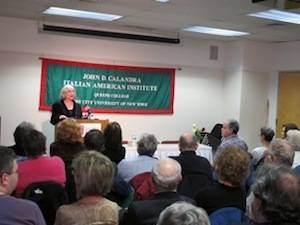Remembering Victims of the Triangle Shirtwaist Fire: Italian and Jewish Immigrants Unite
On January 30th, at the end of “The Week of Remembrance” guests arrived at the Primo Levi Center to commemorate the lives of relatives, friends, and ancestors who perished during the Holocaust of World War II. On March 29th, at the John D. Calandra Institute, the conversation continued.
Unfortunately, the topic was also a tragic one. As this year marks the one-hundredth anniversary of the infamous fire at the Triangle Shirtwaist Factory, the event was held to remember those killed in the factory—female laborers, primarily of Italian and Jewish dissent. Professor Hasia R. Diner, PhD came to Calandra to share her expertise on the issue.
After a respectful introduction, Diner chose to take the conversation in another, perhaps less-expected direction. Rather than discuss the various ways that Italian and Jewish women were victims of the same labor injustices, the conversation was an encouraging glance into the ways in which these two communities managed to peacefully cohabitate the same turf during such difficult times.
Diner, the Paul S. and Sylvia Steinberg Professor of American Jewish History and the Director and the Goldstein-Goren Center for American Jewish History at New York University noted that she was pleasantly surprised to see such a large crowd at Calandra.
She began with a comical anecdote from the memoir of Elizabeth Hasanowitz, a young Jewish girl that had worked at the Triangle Shirtwaist Factory. Hasanowitz recorded her memories of working next to these young Italian women and her fascinations with their different eating habits—the Italians with their eggplant and olive oil sandwiches and the Jewish girls with their baloney meals.
Before the tragic fire, the two separate ethnic groups worked together, ate together and shared conversation. Ultimately, their names would be listed next to one another on the list of over 146 victims from the Triangle Shirtwaist Fire. As Diner aptly stated, “Seeing those names next to one another tells us that something was going on that was and is historically significant; The only thing that separated them from one another was where their name came in the alphabet.”
Despite the flood of cultural diversity to American soil during the great migrations of the early twentieth century, historians demonstrated fascination with the binary between the Italians and Jewish immigrants. This, as Diner emphasized throughout her presentation, makes the topic legitimate and worthy of close attention. To historians and immigrants alike, it was obvious that Italians and Jews shared many things. Both groups migrated as a result of poverty in their respective homelands and with the hopes of finding more promising futures for their children. Both settled in urban environments, as the chance of achieving wealth in the city was higher. With these common interests, they found themselves living and working contiguously, as Diner quotes, “cheek and jowl.”
In the workplace, due to uncertainty and suspicion, the groups were divided at first. It wasn’t long, however, that women in the factories recognized they were experiencing the same unjust labor conditions. The two largest groups in the factories, namely the Triangle Shirtwaist Factory, were Italians and Jewish women. Naturally, they bonded over this strife and formed unions. Their war cry was the same, “We won’t be slaves!”
In the final part of her lecture, Diner covered the paths in which the two cultural groups diverge. First and foremost, they had different intentions for their migrations; the Jews arrived in New York without intentions to ever return home, while the Italians always imagined returning to the motherland. With economic success, Italians moved their families to the outer boroughs of New York where they could have their own land; the Jews, on the contrary, chose to move into more expensive neighborhoods in the city.
These were natural cultural differences, and the focal point of Diner’s conversation remained clear. Something historically pertinent has been and will continue to be shared between these two ethnic communities. It is a relationship that challenges the general cultural stereotypes that so many produce and perpetuate. As those present at the Primo Levi Center earlier this year or at Calandra Institute this week discovered, it is a relationship that operates with deep roots of suffering and survival. Both communities were forced to recognize their unfortunate positions at the time of the Holocaust and then again at the Triangle Shirtwaist Fire. A richer understanding of one another’s experience grew from these circumstances.
Aside from commemorating the victims of the Triangle Shirtwaist Fire, Dr. Hasia Diner invited her audience to seek answers in other aspects of this cultural binary that have yet to be explored. “We need much more scholarship directed toward the ways that the Jewish and Italian laborers encountered one another. What did they say to one another during lunch? What did they talk about?” asks Diner. As recovered memoirs show that both groups were equally intrigued with the other, the subject promises to provide the more personal, missing link to the relationship between Italians and Jewish communities in New York City.










































i-Italy
Facebook
Google+
This work may not be reproduced, in whole or in part, without prior written permission.
Questo lavoro non può essere riprodotto, in tutto o in parte, senza permesso scritto.